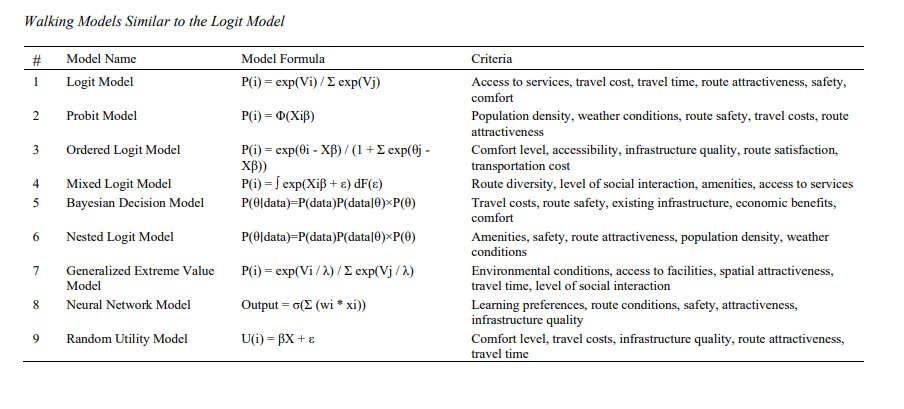Evaluating the Effectiveness of Methods to Divert Intra-city Trips from Motor Vehicles to Walking, Using the X-Minute Zone Approach (Case Study: Tehran City)
Keywords:
Sustainable transport, travel demand management, X-minute city, walking, travel pattern, Tehran cityAbstract
The present study aims to investigate the effectiveness of travel demand management methods and the role of X-minute zones in changing intra-city travel patterns in Tehran. Using a mixed methodology including library and survey studies, this study analyzes the factors affecting the choice of walking and reducing the use of private cars. In the library studies section, by reviewing related scientific articles and texts, the effective criteria for walking were identified and categorized. In the survey section, through questionnaires and simple random sampling, the required data were collected from citizens and analyzed using descriptive and inferential statistical methods. The research findings show that various factors, including the quality of pedestrian infrastructure, the safety of the routes, the appropriate urban design, efficient incentive policies, economic benefits, public health, social interactions, air quality, cultural attractiveness, traffic reduction, the existence of green spaces, cost reduction, mental comfort, impact on lifestyle, environmental motivations, sense of belonging and community, education and information, reduction of environmental stresses, visual appeal, reduction of environmental pollution, reduction of energy consumption, sustainable transport policies, comfort and convenience, tourism opportunities, positive effects on the local economy, suitable weather conditions, physical barriers, suitable space for sports activities, combined transportation, technological infrastructure, positive effects on the environment, lower costs compared to motor transport, interaction with public spaces, development of pedestrian infrastructure and positive user experience affect the choice of walking in intra-city trips. This research emphasizes the importance of sustainable urban planning and the implementation of support policies to promote a culture of walking. The implementation of the "X-minute zones" approach by improving infrastructure, increasing the attractiveness of routes, providing financial and non-financial incentives, and raising public awareness can lead to changes in citizens' travel behavior and reduce dependence on private cars. In addition to reducing traffic and air pollution, this will also help to improve the quality of life, public health and increase social interactions.
References
Adikarya, D. U., & Tanjung, A. S. (2024). Efektivitas Penerapan Smart Mobility Di Kota Bogor Berdasarkan Persepsi Masyarakat. Jurnal Perencanaan Dan Pengembangan Kebijakan, 4(2), 136. https://doi.org/10.35472/jppk.v4i2.1724
Albuquerque, V., Oliveira, A., Barbosa, J. L., Rodrigues, R., Andrade, F., Dias, M. S., & Ferreira, J. C. (2021). Smart Cities: Data-Driven Solutions to Understand Disruptive Problems in Transportation—The Lisbon Case Study. Energies, 14(11), 3044. https://doi.org/10.3390/en14113044
Berdiyorov, A., Berdiyorov, T., Nasritdinov, J., Qarshiboev, S., & Ergashkxodjaeva, S. (2021). A Sustainable Model of Urban Public Mobility in Uzbekistan. Iop Conference Series Earth and Environmental Science, 822(1), 012008. https://doi.org/10.1088/1755-1315/822/1/012008
Brzeziński, Ł. (2024). Social Aspects of Smart Urban Mobility. Encyclopedia, 4(2), 864-873. https://doi.org/10.3390/encyclopedia4020055
Čolaković, A., Memić, B., Karahodža, B., & Goran, N. (2022). Improvement of Urban Mobility Supported With IoT Technologies. 99-105. https://doi.org/10.59478/atct.2022.14
Fontes, T., Arantes, M., Figueiredo, P., & Nováis, P. (2022). A Cluster-Based Approach Using Smartphone Data for Bike-Sharing Docking Stations Identification: Lisbon Case Study. Smart Cities, 5(1), 251-275. https://doi.org/10.3390/smartcities5010016
Fussey, P., & Dalby, J. (2022). Optimisation of Geofencing for Mobility Solutions in Smart Cities. https://doi.org/10.1109/isc255366.2022.9921979
Gulc, A., & Budna, K. (2024). Classification of Smart and Sustainable Urban Mobility. Energies, 17(9), 2148. https://doi.org/10.3390/en17092148
Kayisu, A. K., Mikušová, M., Bokoro, P. N., & Kyamakya, K. (2024). Exploring Smart Mobility Potential in Kinshasa (DR-Congo) as a Contribution to Mastering Traffic Congestion and Improving Road Safety: A Comprehensive Feasibility Assessment. Sustainability, 16(21), 9371. https://doi.org/10.3390/su16219371
Kovačević, A. (2023). The Role of Bike Sharing in Transport Reform: Learning From Comparative Experiences to Develop a Case Study for Belgrade. Slovak Journal of Public Policy and Public Administration, 29-46. https://doi.org/10.34135/sjpppa.230102
Mester, G. (2022). Smart Mobility Solutions in Smart Cities. Interdisciplinary Description of Complex Systems, 20(1), 37-43. https://doi.org/10.7906/indecs.20.1.5
Molina-Navarro, A., Zamora-Castro, S. A., Remess-Perez, M., & Lagunes-Lagunes, E. (2022). Smart Traffic Lights in Sustainable Urban Logistics. Journal Economic Systems, 18-23. https://doi.org/10.35429/jes.2021.9.5.18.23
Molina, C. M., María de la Sierra, R.-T., & Suárez, E. (2022). The Transition of Cities Towards Innovations in Mobility: Searching for a Global Perspective. International journal of environmental research and public health, 19(12), 7197. https://doi.org/10.3390/ijerph19127197
Mykhailova, K. (2023). Implementation of Urban Mobility Projects for Smart Cities: Approaches to Justification and Evaluation. Black Sea Economic Studies(84). https://doi.org/10.32782/bses.84-20
Paalosmaa, T., & Shafie‐khah, M. (2021). Feasibility of Innovative Smart Mobility Solutions: A Case Study for Vaasa. World Electric Vehicle Journal, 12(4), 188. https://doi.org/10.3390/wevj12040188
Paiva, S., Ahad, M. A., Tripathi, G., Feroz, N., & Casalino, G. (2021). Enabling Technologies for Urban Smart Mobility: Recent Trends, Opportunities and Challenges. Sensors, 21(6), 2143. https://doi.org/10.3390/s21062143
Pandian, P., Chavadi, C. A., Ravindran, K., & Sirothiya, M. (2025). Smart Cities, Smart Mobility. 275-304. https://doi.org/10.4018/979-8-3693-6422-2.ch013
Pinsky, M. (2024). Women’s Mobility Challenges and Solutions in Mexico City. Pittsburgh Undergraduate Review, 3(1). https://doi.org/10.5195/pur.2024.56
Pourhashem, G., & Kováčiková, T. (2025). Smart and Innovative Solutions for Maximizing Public Transport Ridership and Passengers’ Satisfaction: Case Study of the City of Žilina. 370-376. https://doi.org/10.1007/978-3-031-85578-8_47
Ptytsia, H., Abramova, L., & ПТИЦЯ, Н. (2024). To the Issue of the Development of Cycling Infrastructure and the Planning of Mobility in Cities. Avtoshliakhovyk Ukrayiny, 3(280), 19-28. https://doi.org/10.33868/0365-8392-2024-3-280-19-28
Rakić, E., Buzdovan, I., & Nedić, Z. (2023). Smarty City With Green Last Mail Delivery. https://doi.org/10.59478/atct.2023.4
Shulajkovska, M., Smerkol, M., Noveski, G., Bohanec, M., & Gams, M. (2024). Artificial Intelligence-Based Decision Support System for Sustainable Urban Mobility. Electronics, 13(18), 3655. https://doi.org/10.3390/electronics13183655
Tho, L. D. (2025). Ho Chi Minh’s Perspective on “Skilful Mass Mobilization” and Its Application in Da Nang City. Vujs, 54(1B), 58-69. https://doi.org/10.56824/vujs.2025b002b
Wawer, M., Grzesiuk, K., & Jegorow, D. (2022). Smart Mobility in a Smart City in the Context of Generation Z Sustainability, Use of ICT, and Participation. Energies, 15(13), 4651. https://doi.org/10.3390/en15134651
Wicaksana, G. B. A. (2020). Future City Based on Smart Mobility Concept: Character and Benchmarking. Journal of Architectural Research and Education, 2(1), 10. https://doi.org/10.17509/jare.v2i1.24112

Downloads
Published
Submitted
Revised
Accepted
Issue
Section
License
Copyright (c) 2025 Arian Ashrafnejad (Author); Mahmoud Saffarzadeh; Saeid Sherafatipour (Author)

This work is licensed under a Creative Commons Attribution-NonCommercial 4.0 International License.









